|
Venice>
Books > Venice
Master Artisans > Artisan profiles
Venice Master Artisans
Book Review
Page 2
Continued from page 1
Examples of Artisan Profiles
Thirty craftsmen are profiled in Venice Master Artisans, with several
pages of photos and text devoted to each. Here are just a few of the
artisans you'll read about in Norbert Heyl and Cristina Gregorin's richly
illustrated book:
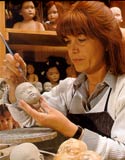 Beatrice
Perini is a "painter, sculptress, creator of papier-m�ché
masks and a teacher" who designs hand-painted china dolls with expressions that
are almost uncanny in their realism. Cristina Gregorin writes: "Her dolls are
made painstakingly down to the very last detail: the clay model is made in
separate pieces, after which the work on the joints is carried out ... A few
weeks later, once the cast has dried out completely, liquid porcelain clay is
poured into it. ... A couple of months are required to complete a doll." Beatrice
Perini is a "painter, sculptress, creator of papier-m�ché
masks and a teacher" who designs hand-painted china dolls with expressions that
are almost uncanny in their realism. Cristina Gregorin writes: "Her dolls are
made painstakingly down to the very last detail: the clay model is made in
separate pieces, after which the work on the joints is carried out ... A few
weeks later, once the cast has dried out completely, liquid porcelain clay is
poured into it. ... A couple of months are required to complete a doll."
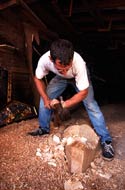 Thom Price
is an American gondola-maker who lives in
Venice. Ms. Gregorin explains: "At the time of the Republic not all
squerarioli, or boat-builders, were born here. Many came from the mountain
areas and being expert wood-carvers they did not find it very difficult to learn
this craft. Thom Price has continued this tradition, because he was born in the
Appalachian mountains in North Carolina." After learning to build fishing boats
in Maine, Price obtained a grant to spend a year in a Venetian squero
before setting up a gondola boatyard of his own. Thom Price
is an American gondola-maker who lives in
Venice. Ms. Gregorin explains: "At the time of the Republic not all
squerarioli, or boat-builders, were born here. Many came from the mountain
areas and being expert wood-carvers they did not find it very difficult to learn
this craft. Thom Price has continued this tradition, because he was born in the
Appalachian mountains in North Carolina." After learning to build fishing boats
in Maine, Price obtained a grant to spend a year in a Venetian squero
before setting up a gondola boatyard of his own.
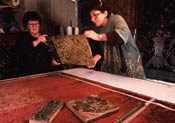 Aglaia and Adriana Minelli
are two sisters who hand-print
velvet fabrics. In her profile of the Minellis, Cristina Gregorin writes: "Great
lengths of iridiscent fabric, mostly featuring geometrical or flower patterns,
are draped casually over chairs or hang on the walls in the vast rectangular
room. ... During the actual printing stage, when Aglaia and Adriana stand in front
of each other, on opposite sides of the large table with the fabric stretched
out between them, they have to work 'like two acrobats on a tightrope', to make
sure that the succession of prints made with the block matches perfectly." Aglaia and Adriana Minelli
are two sisters who hand-print
velvet fabrics. In her profile of the Minellis, Cristina Gregorin writes: "Great
lengths of iridiscent fabric, mostly featuring geometrical or flower patterns,
are draped casually over chairs or hang on the walls in the vast rectangular
room. ... During the actual printing stage, when Aglaia and Adriana stand in front
of each other, on opposite sides of the large table with the fabric stretched
out between them, they have to work 'like two acrobats on a tightrope', to make
sure that the succession of prints made with the block matches perfectly."
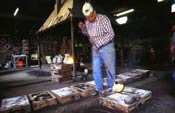 Mario Valese, owner of the only surviving foundry in
Venice, "learnt how to melt metals as a child. Strolling through the city,
Valese brass can be seen everywhere in bells, door-knockers, bras plates and the
faceplates of locks. They have made many ornamental items and collector's items,
such as his famous Saint Mark's Lions, which are also used as awards for the
Venice Film Festival. The most seen of all are, however, the seahorses, which
decorate many gondolas." (Interestingly enough, when the Gran Teatro La Fenice
burned down in 1996, "his playbill frames were among the few things that were
not lost, since bronze only melts at 1000�C.") Mario Valese, owner of the only surviving foundry in
Venice, "learnt how to melt metals as a child. Strolling through the city,
Valese brass can be seen everywhere in bells, door-knockers, bras plates and the
faceplates of locks. They have made many ornamental items and collector's items,
such as his famous Saint Mark's Lions, which are also used as awards for the
Venice Film Festival. The most seen of all are, however, the seahorses, which
decorate many gondolas." (Interestingly enough, when the Gran Teatro La Fenice
burned down in 1996, "his playbill frames were among the few things that were
not lost, since bronze only melts at 1000�C.")
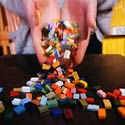 Ruggero and Lucio Orsoni are brothers whose family has
produced glass mosaic tessarae since 1888. Their small firm "is currently
able to produce as many as somewhere between 4 and 5 thousand shades. Ruggero
seems to have inherited his ancestor's talent for alchemy; when he prepares the
mixtures for the vitreous pastes, he shuts himself into his workshop and works
away there on his own. Lucio, on the other hand, is a mosaic worker, and in
addition to designing mosaic decorations for customers, he is also a renowned
artist and creates abstract compositions, in which the possibilities of mosaic
work are exploited to the full." Ruggero and Lucio Orsoni are brothers whose family has
produced glass mosaic tessarae since 1888. Their small firm "is currently
able to produce as many as somewhere between 4 and 5 thousand shades. Ruggero
seems to have inherited his ancestor's talent for alchemy; when he prepares the
mixtures for the vitreous pastes, he shuts himself into his workshop and works
away there on his own. Lucio, on the other hand, is a mosaic worker, and in
addition to designing mosaic decorations for customers, he is also a renowned
artist and creates abstract compositions, in which the possibilities of mosaic
work are exploited to the full."
Next page:
Table of contents: Venice Master Artisans
Venice Master Artisans
photos copyright © 2003 Norbert Heyl.
| |
|